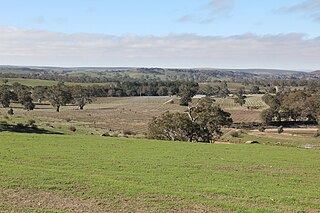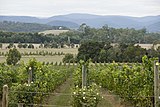Related Research Articles

Three European Union schemes of geographical indications and traditional specialties, known as protected designation of origin (PDO), protected geographical indication (PGI), and traditional speciality guaranteed (TSG), promote and protect names of agricultural products and foodstuffs. Products registered under one of the three schemes may be marked with the logo for that scheme to help identify those products. The schemes are based on the legal framework provided by the EU Regulation No 1151/2012 of the European Parliament and of the Council of 21 November 2012 on quality schemes for agricultural products and foodstuffs. This regulation applies within the EU as well as in Northern Ireland. Protection of the registered products is gradually expanded internationally via bilateral agreements between the EU and non-EU countries. It ensures that only products genuinely originating in that region are allowed to be identified as such in commerce. The legislation first came into force in 1992. The purpose of the law is to protect the reputation of the regional foods, promote rural and agricultural activity, help producers obtain a premium price for their authentic products, and eliminate the unfair competition and misleading of consumers by non-genuine products, which may be of inferior quality or of different flavour. Critics argue that many of the names, sought for protection by the EU, have become commonplace in trade and should not be protected.

The Clare Valley wine region is one of Australia's oldest wine regions, best known for Riesling wines. It lies in the Mid North of South Australia, approximately 142 km north of Adelaide. The valley runs north-south, with Horrocks Highway as the main thoroughfare.

A geographical indication (GI) is a name or sign used on products which corresponds to a specific geographical location or origin. The use of a geographical indication, as an indication of the product's source, is intended as a certification that the product possesses certain qualities, is made according to traditional methods, or enjoys a good reputation due to its geographical origin.
The Swan Valley is a region in the upper reaches of the Swan River between Guildford and Bells Rapids, Western Australia. It is bordered to the east by the Darling Scarp. Both Ellenbrook and Jane Brook lie within the region and discharge into the Swan River. There are seven suburbs within the region: Baskerville, Belhus, Caversham, Henley Brook, Herne Hill, Millendon and West Swan. It is part of the City of Swan local government area.

The Goulburn Valley is a sub-region, part of the Hume region of the Australian state of Victoria. The sub-region consists of those areas in the catchment of the Goulburn River and other nearby streams, and is part of the Murray-Darling Basin. The Goulburn Valley is bordered on the south by the Great Dividing Range and to the north by the Murray River, the state border with New South Wales. The sub-region is one of Australia's most productive and intensively farmed areas and is predominantly irrigated.
Murray Darling is a wine region and Australian Geographical Indication which spans the Murray River and its confluence with the Darling River in northwestern Victoria and southwestern New South Wales. It was registered as a protected name on 16 June 1997.

The South Australian wine industry is responsible for more than half the production of all Australian wine. South Australia has a vast diversity in geography and climate which allows the state to be able to produce a range of grape varieties–from the cool climate Riesling variety in the Clare Valley wine region to the big, full bodied Shiraz wines of the Barossa Valley.
The Alpine Valleys is an Australian wine region on the western slopes of the Victorian Alps in northeast Victoria. It was registered as an Australian Geographical Indication on 29 November 1999 It is bounded to the west by the King Valley and to the north by the Beechworth wine region. The area is distinctly cooler in climate than some of the other northeast wine regions like Rutherglen. The Alpine Valleys produce grapes primarily for table wine production.

Eden Valley wine region is a wine region located in South Australia immediately north of the capital city of Adelaide which covers an area in the Mount Lofty Ranges extending from Truro in the north to just south of Springton in the south. The region received appellation as an Australian Geographical Indication in 1997 and as of 2014, it is represented by at least 36 wineries.

Adelaide Hills is an Australian geographical indication for wine made from grapes grown in a specific area of the Adelaide Hills east of Adelaide in South Australia.
Riverina is an Australian Geographical Indication (AGI) registered in the Register of Protected GIs as a wine region. The Riverina AGI is centred on Griffith and is roughly circular with towns on the boundary including Mossgiel, Condobolin, Temora, Junee, Culcairn, Berrigan, Barooga, Finley, Deniliquin and Moulamein. It does not extend as far south as the Murray River. As such, the Riverina wine region is smaller than the generally known Riverina area.
Swan Hill is a wine region name protected by an Australian Geographical Indication (AGI). It is named for the town of Swan Hill on the south side of the Murray River in the Australian state of Victoria. The wine region spans the Murray and the north eastern part of the region is in the state of New South Wales. The north-eastern part of the region is in the New South Wales zone of Big Rivers. The southern and western parts are in the Victoria zone of North West Victoria. The region spans from Lake Charm and Benjeroop in the southeast through Lake Boga and Swan Hill to past Piangil and Tooleybuc in the north.
Cowra is a wine region and Australian Geographical Indication in the Central Ranges zone in the Australian state of New South Wales. It is named for the town of Cowra.
Mudgee is a wine region and Australian Geographical Indication in the Central Ranges zone in the Australian state of New South Wales. It is named for the town of Mudgee.

Orange is a wine region and Australian Geographical Indication in the Central Ranges zone in the Australian state of New South Wales. It is named for the town of Orange and defined as the contiguous area that is above 600 metres (2,000 ft) elevation within the City of Orange, Cabonne Shire and Blayney Shire.
The Glenrowan wine region is a wine growing region in the Australian state of Victoria, including the town of Glenrowan.

Goulburn Valley wine region is a wine region in the state of Victoria in Australia. It is part of the Central Victoria zone and roughly corresponds to the Goulburn Valley tourist and government region.
Nagambie Lakes is a subregion of the Goulburn Valley wine region in the Australian state of Victoria. Lake Nagambie on the Goulburn River is the largest waterbody in the region, and Nagambie is the main town.
Upper Goulburn is a wine region in the Australian state of Victoria. It was designated as an Australian Geographical Indication on 14 October 2003. It is located north of the Yarra Valley wine region on slopes that drain to the north and west into the Goulburn River and eventually the Murray River. To its north are the wine regions of Goulburn Valley, Strathbogie Ranges and King Valley.
Western Plains is an Australian Geographical Indication for a grape growing zone encompassing most of northwestern New South Wales in Australia. It was entered in the Register of Protected Names on 1 May 1996. There are no regions defined in the zone. Most of this zone is arid and unsuitable for grape growing.
References
- 1 2 "Sunbury". Discover Australian Wine. Wine Australia . Retrieved 23 October 2020.
- ↑ "Geographical indications". Register of Protected GIs and Other Terms. Wine Australia . Retrieved 23 October 2020.
- ↑ "Sunbury Geographical Indication". Register of Protected GIs and Other Terms. Wine Australia . Retrieved 23 October 2020.
- ↑ "Sunbury, Victoria". James Halliday Australian Wine Companion. Retrieved 23 October 2020.
